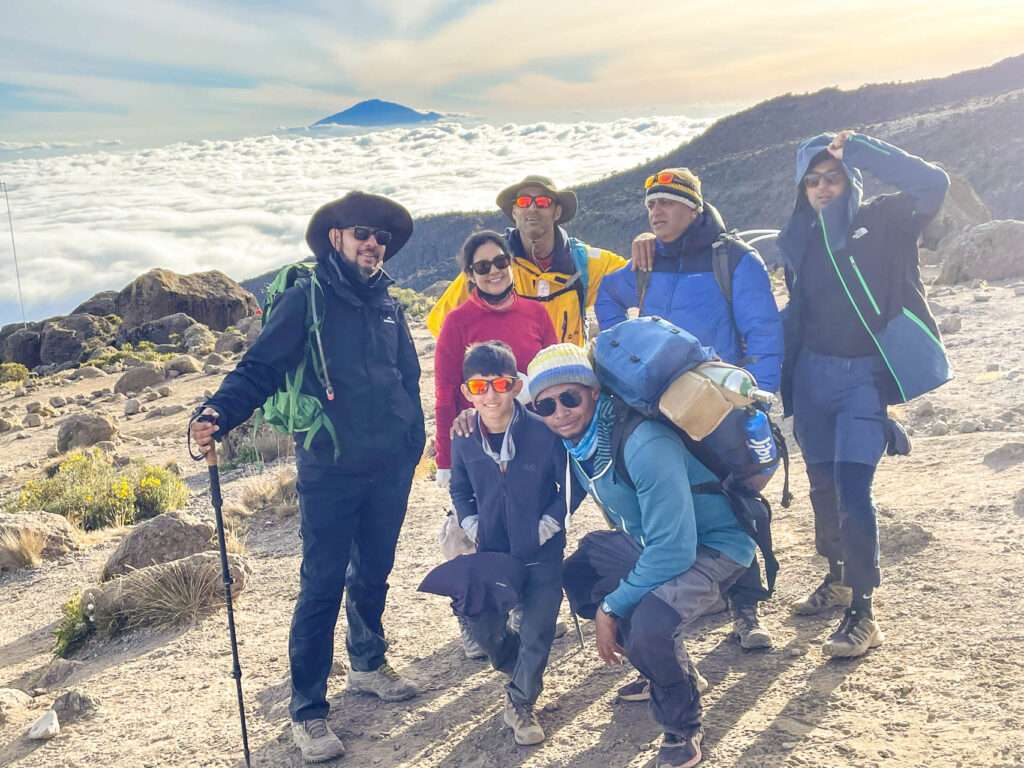Training to Climb Kilimanjaro
How to train for your Kilimanjaro climb?
Ascending Kilimanjaro isn’t about technical climbing but rather an extensive hike over multiple days in high-altitude conditions. The challenge can be grueling, particularly on the night of the summit push. At altitude, the thin air can make the journey feel like an arduous endeavor. To ensure a safe and comfortable climb instead of a tiring ordeal, physical preparedness is key. But how exactly should one train for Kilimanjaro?
Contrary to popular belief, peak physical fitness doesn’t automatically guarantee a successful summit. Even the most athletic individuals might struggle with altitude-related effects. Conquering Kilimanjaro doesn’t demand elite athleticism because ultimately, it’s the altitude that dictates success.

Nevertheless, being in better physical shape may reduce the strain on your aerobic capacity during the trek, making it easier to adapt to the altitude’s stressors.
Considerations to keep in mind:
- Slow hiking at altitude feels more demanding than a faster pace at sea level.
- Expect to hike 6-8 hours daily, then repeat it for consecutive days, including a lengthy 10+ hour journey on summit night/day.
- Trails are often steep, rocky, and uneven.
- Mental resilience is crucial.
While fitness alone won’t aid altitude acclimatization, being in top form offers several advantages:
- Faster recovery from daily exertion, ensuring energy for the next day’s hike.
- Enhanced oxygen supply to muscles.
- Stronger legs for tackling uphill and downhill sections.
- Improved balance and flexibility to minimize injuries.
- Better appreciation of your surroundings.
Keep these points in mind: - Break in your hiking boots beforehand; try different sock combinations during practice hikes.
- Familiarize yourself with wearing a loaded daypack to acclimate your shoulders and back.
- Practice layering clothes efficiently for quick adjustments during the trek.
- If planning to use hiking poles, practice with them beforehand.
There isn’t a one-size-fits-all fitness regimen for Kilimanjaro. The required training varies based on individual fitness levels. Incorporating uphill hikes for those already active or starting with basic exercises for less active individuals might be necessary.
Note: Prior to any training program or changes, consult a healthcare professional. A medical check-up before undertaking high-altitude treks is essential. This information serves for informational purposes only.
Preparing Physically for Kilimanjaro
The approach to a Kilimanjaro fitness regimen varies based on your current exercise routine, physical condition, and any existing injuries. Attaining superhuman fitness levels isn’t necessary; given ample time and medical approval, most healthy individuals can condition themselves adequately for the climb.
It’s about conditioning your body to meet the specific demands of the trek.
Key areas to focus on:
- Endurance & Cardiovascular Fitness
- Leg, Core & Back Strength
- Flexibility and Balance (through stretching)
- Mental Stamina
Essential Tips for an Effective Fitness Program
Simplicity and Sustainability
Choose exercises you enjoy. Whether it’s cycling, running, or any activity you relish, ensure a progressive approach to build stamina consistently.
Consider High-Intensity Interval Training (HIIT) if time is limited. It enhances muscle work capacity and cardiovascular endurance.
Incorporate Exercise into Daily Life
Besides structured workouts, seize everyday opportunities to move more. Use a weighted daypack when walking the dog or opt for stairs instead of elevators. Any activity that keeps you active is beneficial.
Outdoors or Gym Workouts
Whenever feasible, put on your hiking gear and venture outdoors. Hill hiking and navigating rough terrain mimic mountain conditions, boosting your readiness for the climb. If hills aren’t accessible, utilize gym equipment like inclined treadmills or the stair climber, ensuring you’re suited up in hiking gear for practice.
Gradual Progression & Self-awareness
Challenge yourself but avoid overexertion. Gradually escalate your training intensity to foster fitness improvements without risking burnout. Listen to your body’s cues to avoid pushing beyond your limits.
Seek Professional Guidance
If unsure about crafting a training plan, consider consulting a personal trainer or using online programs for guidance.
Remember, achieving peak fitness for Kilimanjaro is about gradual progress, tailored exercises, and being mindful of your body’s signals. Consulting with a fitness professional can be a supportive step toward achieving your trekking goals.
The Significance of Adequate Rest & Recovery
Navigating the thin line between pushing oneself and overexertion is crucial. Muscle soreness, exhaustion, sleep disturbances, and potential injuries may signify going beyond your body’s limits.
Commence your Kilimanjaro training well in advance (3-6 months). Quality training isn’t an instant achievement; it’s a sustained effort built over time.
Avoiding Plateaus
Revamp your workouts every 3-4 weeks, introducing diversity into your regimen. If you stick to the same routine consistently, your body adapts, requiring greater effort for similar results. Shifting to different workouts challenges your body anew, stimulating fresh adaptations.
Note: This is why solely walking for Kilimanjaro preparation might not suffice. Your body adjusts swiftly to sea-level walking unless you engage in multiple hours of daily hiking.
Tapering Training
Approximately two weeks before your climb, maintain training but dial down the intensity. Arriving at the climb’s onset fresh and rejuvenated is crucial while minimizing injury risks.
Building Endurance and Cardiovascular Fitness
Endurance pertains to the body’s capacity for sustained effort over prolonged periods. Training for endurance systematically enhances metabolism, bolstering oxygen efficiency and muscle energy production.
- Activities such as biking, swimming, jogging, stair climbing, or elliptical workouts can be ramped up to 60-90 minutes at roughly 70% of your maximum heart rate.
- High-Intensity Interval Training (HIIT) serves as a time-efficient alternate workout stimulus.
- Regularly don your weighted daypack and hiking boots, endeavoring on challenging hikes, preferably with elevation changes.
- Consider integrating specific altitude training techniques to acclimate your body to reduced oxygen levels on the mountain.
Preparing for Kilimanjaro: Fitness and Beyond
Strength, Flexibility, and Balance
What exactly is strength? It’s about performing the most work with minimal effort. As you ascend Kilimanjaro, altitude adds an extra challenge. You’ll want your body to efficiently manage the trekking work demanded.
- Target lower body strength with squats, lunges, and exercises for your leg muscles.
- Enhance core strength for better stability on uneven terrain.
- Build upper body strength to manage your daypack.
Strong legs are essential for ascending, and descending sections can strain hips, knees, and thighs. A robust strength training program fortifies large muscle groups and stabilizes smaller ones, reducing injury risks.
While you needn’t go full-bodybuilder, incorporating resistance training 2-4 times weekly can yield long-term benefits. If you’re new to weight training, consulting a personal trainer is highly recommended.
Stretching, Flexibility, and Yoga
During extensive cardio or strength training, flexibility is often overlooked. Stretching before and after exercises lowers the risk of injury, enhances balance, and aids muscle recovery.
Adding yoga to your routine can help refine breathing techniques, posture, and maintain composure and focus for the challenges ahead.
Breathing Techniques and Body Awareness
Controlled breathing is vital in thin mountain air. Mindful, deep breaths prevent inadequate oxygen intake and undue stress. Yoga, meditation, or specific breathing practices can augment body awareness, enabling quicker detection of any discomfort or issues.
Injury Prevention and Addressing Existing Injuries
Most of us have some physical limitations. Recognizing these (consult your doctor if unsure) helps in better preparation.
- Seek advice for support gear if needed for problematic areas like knees.
- Enlist a personal trainer to develop exercises targeting weaknesses.
- Soft-tissue work or sports massage can alleviate muscle tightness.
- Warm-ups and cooldowns before and after intense workouts prevent injuries.
During the Climb
- Opt for the longest route for better acclimatization.
- Pace yourself; there’s no rush. Conserve energy.
- Stay hydrated and maintain regular meals.
- Utilize hiking poles for balance.
- Attend to any foot “hotspots” to prevent blisters.
- Learn the “rest step” hiking technique for brief muscle relaxation.
Mental Resilience
Climbing Kili is a test of mental strength. The arduous hikes, altitude effects, and cold nights demand perseverance.
- Remember your motivation for embarking on this journey.
- Practice mindfulness or meditation for mental fortitude.
- Achieving personal bests can boost confidence.
- Be confident but not complacent; stay informed.
- Remind yourself of past triumphs to bolster confidence.
- Educate yourself about the challenge ahead and Kilimanjaro itself.
- Take it one step, one breath, one achievement at a time.
Nutrition
During the climb, we provide balanced meals catering to various dietary needs. Pre-climb, follow a healthy diet aligned with your goals for optimal results.
In Summary
Anyone in good health can prepare for Kilimanjaro. It’s not about magic formulas but consistent effort. Avoid comparing yourself to others; altitude affects everyone differently. Be your best self, seek guidance if needed, and prepare for an adventure of a lifetime!
Questions? Contact Golden Kit Tours and Safaris to start with your personalized training now or book your adventure with us.

